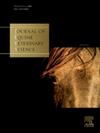Comparison of techniques for sperm evaluation in Purebred Spanish Horses
IF 1.3
3区 农林科学
Q2 VETERINARY SCIENCES
引用次数: 0
Abstract
The present study was designed to compare methods of sperm assessment in Purebred Spanish Horses, to evaluate different staining methods and to facilitate routine handling and work both in research laboratories and in the field. The parameters evaluated were acrosome integrity, capacitation, and sperm protamination. Semen was collected from February to May 2024 from 11 PRE stallions (three replicates of each). Immediately after collection, samples were diluted in INRA96 to a final concentration of 100 × 106 sperm/mL and maintained at room temperature. For the examination of acrosome integrity, smears stained with Eosin-Nigrosin-Giemsa (ENG) were compared with smears stained with peanut agglutinin (PNA). Capacitation was evaluated by analyzing smears stained with PNA compared with samples fixed in 2% glutaraldehyde in cacodylate buffer and stained with Hoechst 33258 and chlortetracycline (CTC). Finally, for the analysis of protamination, smears stained with chromomycin A3 (CMA3), methylene blue (Diff-Quik), aniline blue, or toluidine blue were compared. Significant differences (p<0.05) between techniques were found using a paired t-test, when comparing two groups, or one-way-ANOVA, when comparing four groups; correlation tests were also performed (GraphPad Prism v9). The percentage of sperm with intact acrosomes identified with ENG was higher than with PNA, whereas sperm with damaged acrosomes with ENG was lower than with PNA. Conversely, the percentage of sperm with lost acrosomes was similar between the two techniques. Microscopic evaluation of sperm stained with ENG was more complex and time-consuming compared with PNA staining. The percentage of capacitated sperm analyzed with PNA and CTC, showed no significant differences between the two methods. For these two parameters, the correlations between the methods studied were not significant. Finally, chromatin compaction alterations showed significant differences between aniline blue (1.3±0.6%) and both Diff-Quik (4.0±0.7%) and toluidine blue (3.5±0.4%), whereas CMA3 (2.4±0.5%) were similar when compared with the other methods. The only significant correlation (0=0.019) appeared between CMA3 and aniline blue (Pearson r=0.69). It is noteworthy that these staining techniques evaluate different aspects of the chromatin, which may be the reason of the observed differences. Therefore, a reference technique, such as SCSA, would be a good option for the comparison of these 4 methods. Future studies should focus on the identification of a method of reference for each parameter to perform regression studies that allow us to model differences and generate an algorithm so the different staining techniques may be used in different laboratories or in the field and be comparable.
西班牙纯种马精子鉴定技术的比较
本研究旨在比较纯种西班牙马的精子评估方法,以评估不同的染色方法,并促进研究实验室和现场的日常处理和工作。评估的参数是顶体完整性、获能性和精子蛋白化。于2024年2月至5月采集11匹PRE种马(每匹3个重复)的精液。采集后立即用INRA96稀释至终浓度为100 × 106个精子/mL,室温保存。为了检查顶体的完整性,将eosin - nigroin - giemsa (ENG)染色与花生凝集素(PNA)染色进行比较。将PNA染色的样品与2%戊二醛固定在乙酸甲酯缓冲液中、Hoechst 33258和氯四环素(CTC)染色的样品进行比较,评价其获能性。最后,为了分析蛋白化作用,比较染色染色为色霉素A3 (CMA3)、亚甲基蓝(Diff-Quik)、苯胺蓝或甲苯胺蓝的涂片。两组比较采用配对t检验,四组比较采用单因素方差分析(one-way-ANOVA),技术间差异显著(p<0.05);还进行了相关检验(GraphPad Prism v9)。顶体完好的精子经ENG鉴定的比例高于经PNA鉴定的比例,顶体受损的精子经ENG鉴定的比例低于经PNA鉴定的比例。相反,两种技术中失去顶体的精子百分比是相似的。与PNA染色相比,ENG染色精子的显微评价更为复杂和耗时。PNA和CTC分析的能性精子百分比在两种方法之间无显著差异。对于这两个参数,所研究的方法之间的相关性不显著。最后,染色质压实变化在苯胺蓝(1.3±0.6%)与dif - quik(4.0±0.7%)和甲苯胺蓝(3.5±0.4%)之间存在显著差异,而CMA3(2.4±0.5%)与其他方法相似。CMA3与苯胺蓝之间仅有显著相关(0=0.019)(Pearson r=0.69)。值得注意的是,这些染色技术评估染色质的不同方面,这可能是观察到差异的原因。因此,参考技术,如SCSA,将是比较这4种方法的一个很好的选择。未来的研究应侧重于确定每个参数的参考方法,以进行回归研究,使我们能够模拟差异并生成算法,以便不同的染色技术可以在不同的实验室或现场使用并具有可比性。
本文章由计算机程序翻译,如有差异,请以英文原文为准。
求助全文
约1分钟内获得全文
求助全文
来源期刊

Journal of Equine Veterinary Science
农林科学-兽医学
CiteScore
2.70
自引率
7.70%
发文量
249
审稿时长
77 days
期刊介绍:
Journal of Equine Veterinary Science (JEVS) is an international publication designed for the practicing equine veterinarian, equine researcher, and other equine health care specialist. Published monthly, each issue of JEVS includes original research, reviews, case reports, short communications, and clinical techniques from leaders in the equine veterinary field, covering such topics as laminitis, reproduction, infectious disease, parasitology, behavior, podology, internal medicine, surgery and nutrition.
 求助内容:
求助内容: 应助结果提醒方式:
应助结果提醒方式:


